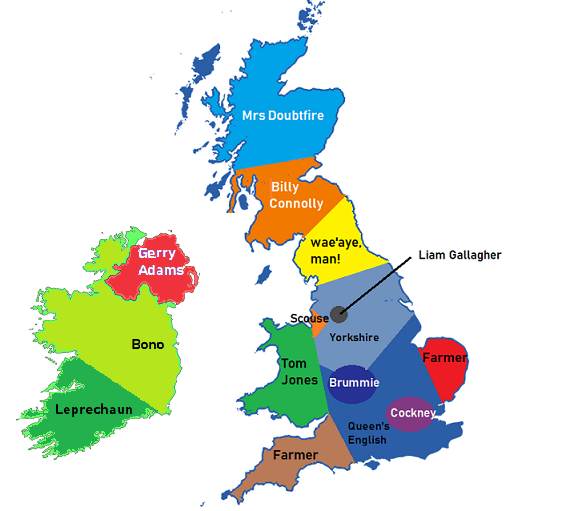Phonology and Pronunciation
The importance of pronunciation in English
English phonology is the sound system of the English language. In natural speech, the sounds that make up informal speech patterns of English are often difficult to distinguish.
It is especially hard for non-native speakers to understand sentences when they are spoken quickly because each sound can appear to be running into the next. It takes good listening practice to be able to uncover the different sounds that make up individual words.
It is important for non-native speakers to try to incorporate a good English accent into their English language learning in order to make their own speech and their own pronunciations sound more natural.
If an accent is not natural-sounding and English stress patterns are not correct, it can be very difficult for a native English speaker to understand the non-native speaker, even if the grammar is perfect and the vocabulary is correct.
Native speakers of English pronounce words without thinking about it. However, non-native English speakers need to learn to recognise the speech patterns used by native speakers and to use them themselves if they are to be understood.
Learning about all the aspects of English phonology will enable the non-native speaker to communicate much more easily.
English Phonology and Accent
Some areas of England have strong regional dialects and accents which can be difficult for non-native English speakers (and sometimes native English speakers!) to understand.
Regions with strong accents include Liverpool (‘Scouse’), Newcastle upon Tyne (‘Geordie’), and Birmingham (‘Brummie’).
There are many accents and some overlaps with English people often able to guess where exactly in the country a person comes from by listening to their accent.
Check out our Cockney Rhyming Slang page for special phrases from the East End of London. There are many different accents across the United States too, with some Southern states having an accent that might be quite difficult for non-native speakers to understand.
Syllables, Stress, Rhythm and Intonation
All English words are pronounced in a certain way, with the stress coming on different syllables. If you put the stress in the wrong place, it can change the sense of the word completely.
Read all about syllables and stresses in English. Rhythm and intonation also change the way words are pronounced in English. Explore more about rhythm and intonation in English to enhance your pronunciation further.
Spelling to Sound Correspondence
‘Lax’, ‘Tense’, ‘Heavy’ and ‘Tense-R’ vowels
In English phonology, there are twenty main orthographic vowels of stressed syllables. Some linguists have grouped these into four main categories: ‘Lax’, ‘Tense’, ‘Heavy’ and Tense-R’.
Tense and lax vowels
Tense vowels are distinguished from lax vowels by adding a silent ‘e’ at the end of the word.
So, the letter ‘a’ in the word ‘mat’ is lax (a hard sound), but when the letter ‘e’ is added to the end of the word it becomes the word ‘mate’ with the letter ‘a’ now changing to become tense.
Heavy and tense r-vowels
Similarly, heavy and tense-r vowels are patterned together. This means the letters ‘ar’ in the word ‘bar’ are heavy. But if we add an ‘e’ to the word, it becomes ‘bare’ and the vowel ‘a’ is now tense.
The letter ‘u’
The letter ‘u’ represents two different vowel patterns. The first ‘u’ sound is the word ‘cup’ and the second in he word ‘blue’.
Diagraphs
Another way of indicating tense and tense-r vowels is by the addition of another orthographic vowel forming a digraph (two letters together).
The first vowel here is usually the main vowel while the second vowel is the ‘marking’ vowel which determines if the sound is lax or tense.
For example, the word ‘pan’ has a lax ‘a’, creating a hard ‘a’ sound. But if we add the letter ‘i’ after the ‘a’ to create the digraph ‘ai’, the word changes to ‘pain’ and the ‘a’ is now tense.
In this example, the ‘i’ changed the sound the ‘a’ from lax to tense, thus changing ‘pan’ to ‘pain’: a new word and a new pronunciation of the letter ‘a’.
Learn more about diagraphs in our English orthography section.
Homophones
Homophones are words that have different meanings and usually different spellings but are pronounced exactly the same. For example:
- pale and pail
- tale and tail
- plane and plain
- sale and sail
- bale and bail
All of these words use the silent ‘e’ for the first word and the diagraph for the second. This use of the silent ‘e’ and the diagraph distinguishes between words that would otherwise be homonymous.
Homonyms are words that are spelled and pronounced the same but have different meanings, for example: rose (the past tense of rise) and rose (the flower).
Words that are spelled the same but are pronounced differently are called homographs. For example: row (an arrangement of items in a line) and row (an argument).
Homophones can also be phrases that sound the same or very similar but have different meanings. For example: deep end and depend.
Examples of homophones in English:
- bear / bare
- bee / be
- cell / sell
- dear / deer
- die / dye
- draft / draught
- him / hymn
- main / mane
- knight / night
- morning / mourning
- not / knot
- oar / or
- pane / pain
- peace / piece
- red / read
- right / write
- root / route
- see / sea
- sew /so
- side / sighed
- sort / sought
- sun / son
- sweet / suite
- to / too / two
- toe / tow
- wait / weight
- wear / where
The above examples assume British English pronunciation, although regional pronunciations may vary.
‘Ough’ Words
There are many ways to pronounce the letter combination ‘ough’ in English. The words ‘cough’, ‘tough’ and ‘though’ all have different pronunciations and there are many others. Read more about ‘ough’ words in our English Orthography section.
Natural Speech
The way in which native speakers pronounce words in formal settings can often sound different in relaxed conversations with other native speakers.
Words can sound as though they merge together in rapid speech and can be almost indeterminable to the non-native ear, especially if speakers have heavy accents or are not speaking ‘good’ English.
For example, the use of the suffix ‘n’t’ creates a negation of the verb and is very common in rapid speech.
The speech sound of this ‘nt’ sound tagged onto the end of a word allows the speaker to speak more quickly and smoothly. This is a good strategy to try as a non-native English speaker to make your speech sound more natural.
See our phrasal verbs and idioms of the English language section to read more about natural speech.
For a more comprehensive look at English phonology, explore more about syllables and stress, rhythm, intonation and silent letters in English.
Share your thoughts on English phonology
Which areas of English pronunciation do you find the most challenging?
What ares of phonology would you like to learn more about?
Which elements of English phonology are the most different from the speech patterns of your own native language?
Do you think native speakers of certain languages would find English phonology particularly difficult? If so, which L1 languages pose the most problems when learning English pronunciation?




This is all very interesting to me and I would like to know more. I want to know about syllabalic division of English words. I want to know about things like “silent letters” and letter combinations that create the various sounds of the language. In short the entire and exhaustive system of English Phonology.
I am an adult literacy tutor at the Brooklyn Public Library.
Hi Rohan,
Thanks for your comment. English phonology is certainly fascinating! Have you seen the ‘Syllables and Stress’ page within our phonology guide? This explores the syllable divisions in English a little further, including a discussion of weak vowels.
We have also recently added a guide to rhythm and intonation in English. I hope you find these interesting.
Of course phonology is a huge subject so there is always more to explore! We are regularly adding new material and will soon be adding a section about silent letters, so do keep popping back. Good luck with your English phonology research
Best wishes,
Catherine
interesting